
Aerospace and defense company Woodward (NASDAQ: WWD) met Wall Street’s revenue expectations in Q4 CY2024, but sales fell by 1.8% year on year to $772.7 million. The company’s outlook for the full year was close to analysts’ estimates with revenue guided to $3.4 billion at the midpoint. Its non-GAAP profit of $1.35 per share was 13.9% above analysts’ consensus estimates.
Is now the time to buy Woodward? Find out by accessing our full research report, it’s free.
Woodward (WWD) Q4 CY2024 Highlights:
- Revenue: $772.7 million vs analyst estimates of $775.3 million (1.8% year-on-year decline, in line)
- Adjusted EPS: $1.35 vs analyst estimates of $1.18 (13.9% beat)
- Adjusted EBITDA: $134.9 million vs analyst estimates of $132 million (17.5% margin, 2.2% beat)
- The company reconfirmed its revenue guidance for the full year of $3.4 billion at the midpoint
- Adjusted EPS guidance for the full year is $6.05 at the midpoint, roughly in line with what analysts were expecting
- Operating Margin: 15.5%, up from 12.6% in the same quarter last year
- Free Cash Flow Margin: 0.1%, similar to the same quarter last year
- Market Capitalization: $11 billion
“We’re pleased with our strong start to 2025, as our first quarter results were in line with our expectations. Our Aerospace segment performed well with growth in both sales and margin despite a pause in deliveries for some Boeing product lines and a reduced delivery rate in others,” said Chip Blankenship, Chairman and Chief Executive Officer.
Company Overview
Initially designing controls for water wheels in the early 1900s, Woodward (NASDAQ: WWD) designs, services, and manufactures energy control products and optimization solutions.
Aerospace
Aerospace companies often possess technical expertise and have made significant capital investments to produce complex products. It is an industry where innovation is important, and lately, emissions and automation are in focus, so companies that boast advances in these areas can take market share. On the other hand, demand for aerospace products can ebb and flow with economic cycles and geopolitical tensions, which can be particularly painful for companies with high fixed costs.
Sales Growth
A company’s long-term sales performance can indicate its overall quality. Any business can put up a good quarter or two, but many enduring ones grow for years. Regrettably, Woodward’s sales grew at a sluggish 2.2% compounded annual growth rate over the last five years. This was below our standards and is a tough starting point for our analysis.
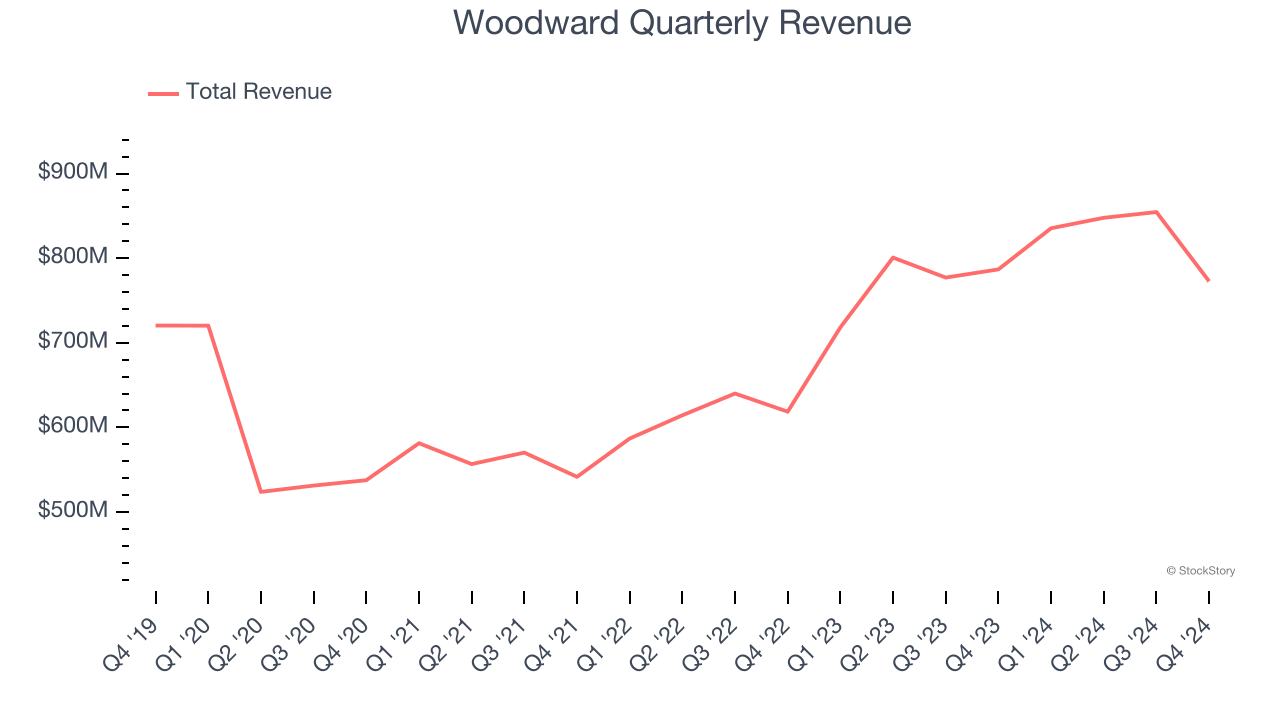
We at StockStory place the most emphasis on long-term growth, but within industrials, a half-decade historical view may miss cycles, industry trends, or a company capitalizing on catalysts such as a new contract win or a successful product line. Woodward’s annualized revenue growth of 16% over the last two years is above its five-year trend, suggesting its demand recently accelerated. 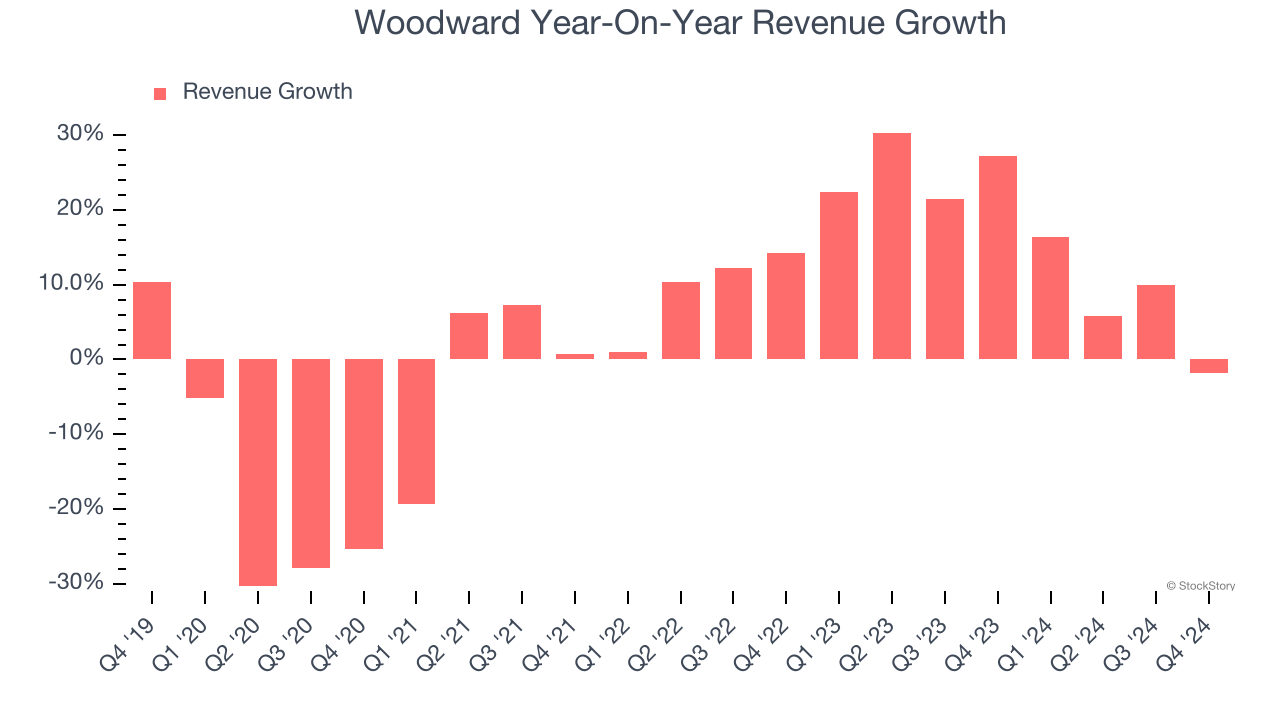
This quarter, Woodward reported a rather uninspiring 1.8% year-on-year revenue decline to $772.7 million of revenue, in line with Wall Street’s estimates.
Looking ahead, sell-side analysts expect revenue to grow 5.3% over the next 12 months, a deceleration versus the last two years. This projection doesn't excite us and suggests its products and services will see some demand headwinds.
Here at StockStory, we certainly understand the potential of thematic investing. Diverse winners from Microsoft (MSFT) to Alphabet (GOOG), Coca-Cola (KO) to Monster Beverage (MNST) could all have been identified as promising growth stories with a megatrend driving the growth. So, in that spirit, we’ve identified a relatively under-the-radar profitable growth stock benefiting from the rise of AI, available to you FREE via this link.
Adjusted Operating Margin
Woodward has managed its cost base well over the last five years. It demonstrated solid profitability for an industrials business, producing an average operating margin of 11%.
Looking at the trend in its profitability, Woodward’s operating margin rose by 2.4 percentage points over the last five years, showing its efficiency has improved.
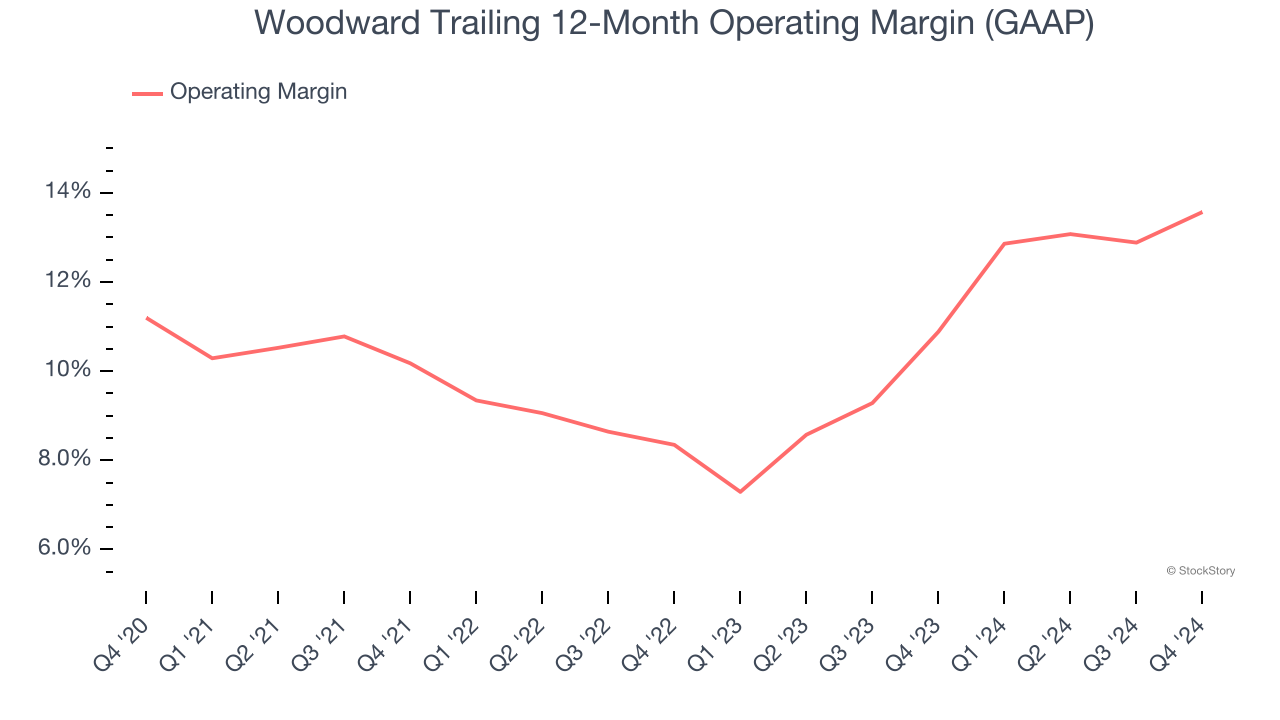
This quarter, Woodward generated an operating profit margin of 15.5%, up 2.9 percentage points year on year. This increase was a welcome development, especially since its revenue fell, showing it was recently more efficient because it scaled down its expenses.
Earnings Per Share
We track the long-term change in earnings per share (EPS) for the same reason as long-term revenue growth. Compared to revenue, however, EPS highlights whether a company’s growth is profitable.
Woodward’s EPS grew at a weak 3.7% compounded annual growth rate over the last five years. On the bright side, this performance was better than its 2.2% annualized revenue growth and tells us the company became more profitable on a per-share basis as it expanded.
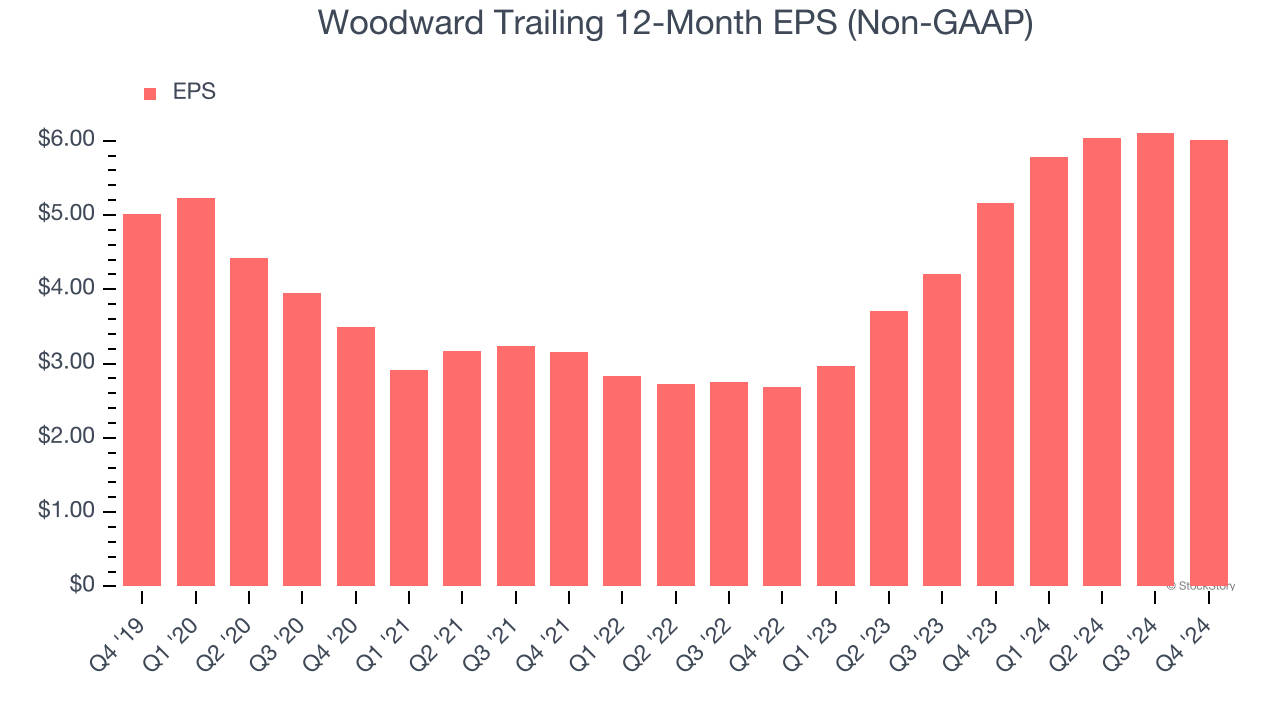
We can take a deeper look into Woodward’s earnings to better understand the drivers of its performance. As we mentioned earlier, Woodward’s operating margin expanded by 2.4 percentage points over the last five years. On top of that, its share count shrank by 5.5%. These are positive signs for shareholders because improving profitability and share buybacks turbocharge EPS growth relative to revenue growth. 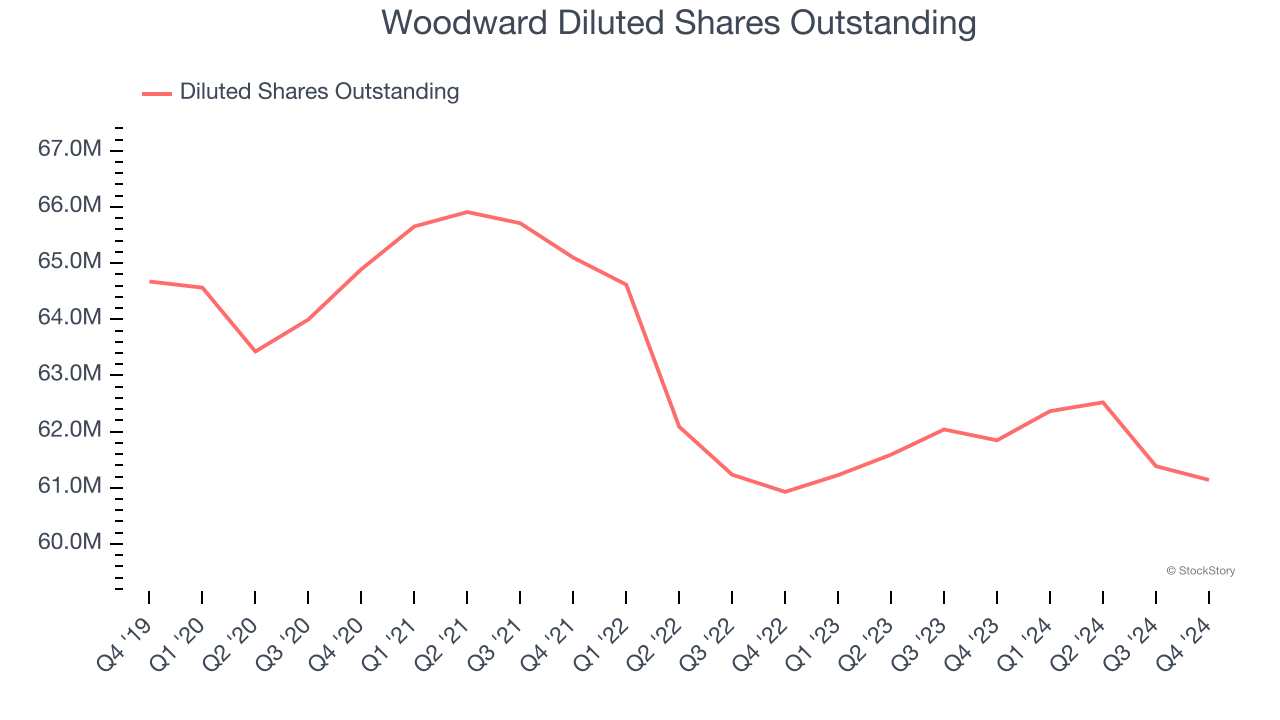
Like with revenue, we analyze EPS over a more recent period because it can provide insight into an emerging theme or development for the business.
For Woodward, its two-year annual EPS growth of 49.6% was higher than its five-year trend. This acceleration made it one of the faster-growing industrials companies in recent history.
In Q4, Woodward reported EPS at $1.35, down from $1.45 in the same quarter last year. Despite falling year on year, this print easily cleared analysts’ estimates. Over the next 12 months, Wall Street expects Woodward’s full-year EPS of $6.01 to grow 7.9%.
Key Takeaways from Woodward’s Q4 Results
We enjoyed seeing Woodward exceed analysts’ EPS expectations this quarter. On the other hand, its revenue in the quarter and its full-year revenue guidance were just in line with Wall Street’s estimates. Most other aspects of previously-provided 2025 guidance remained unchanged. The market seemed to expect more, and the stock traded down 4.7% to $179.09 immediately following the results.
Is Woodward an attractive investment opportunity at the current price? When making that decision, it’s important to consider its valuation, business qualities, as well as what has happened in the latest quarter. We cover that in our actionable full research report which you can read here, it’s free.





